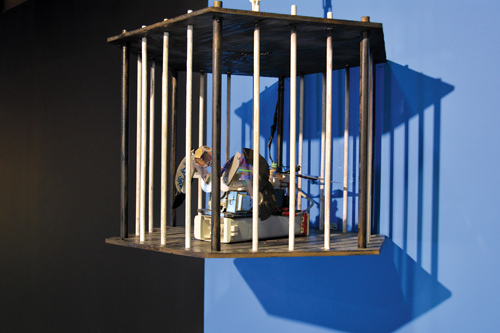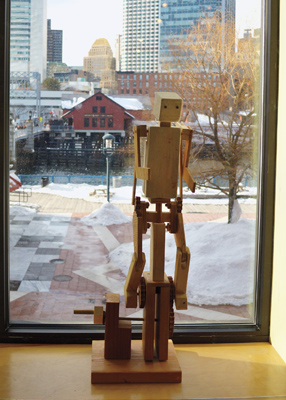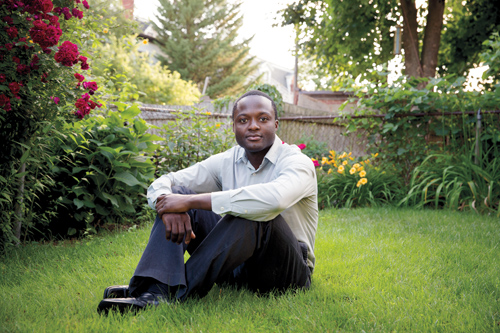By Katherine Duke ’05
Wrenford Thaffe ’13 took his honors exhibition to the Boston Children’s Museum. [Sculpture] Inside the Boston Children’s Museum, a wooden cage hung from the ceiling. The “bird” inside was made of printer parts, an egg beater and some old CDs, as well as an electrical transformer and a remote-controlled toy car. When kids and parents pressed its buttons, the creature flapped its wings.

Right: The “bird” inside
the cage is made of printer parts, an egg beater, old CDs, an electrical transformer and a remote-controlled toy car.
When Thaffe was a child in rural Jamaica, he drew in a sketchbook, designed homes for his pets and observed his father’s farm work. Upon learning about electrolysis in high school, he went home to run experiments with batteries and fluids. “My parents grew accustomed to seeing many glass containers with weird-looking liquids around the house—all in the name of science,” he says.
He declared a chemistry major at Amherst but also studied political science, sociology and art. In Professor Carol Keller’s introductory sculpture course, he used wood and wire to build a motorized model of a chlorophyll molecule. “This was the first time I combined art and science in a deliberate way,” he says. “I soon saw that double-majoring in chemistry and art was a beautiful possibility.”

Left: “Running Man,” part of the Children’s Museum exhibit, was inspired by Thaffe’s four years on the track team at Amherst.
Thaffe’s senior honors exhibition in Fayerweather Hall, The Reincarnation of Sculptural Forms, featured the aforementioned bird, as well as a 6-foot-long kinetic plywood fish and “a wooden freestanding quadruped” with gears inside.
He also used a garage-door opener to control a Roomba vacuum cleaner, which he’d equipped with a marker on a swinging arm, allowing it to draw circles on the floor. And he built a humanoid figure out of a printer and fax machine. Activating the printer’s motor triggered the figure’s translucent rubber eyeballs to roll—the idea being “to animate the ghostly sounds you hear when you reboot a printer.” The exhibition garnered Thaffe the college’s Athanasios Demetrios Skouras Prize.
Before graduating, Thaffe asked the Boston Children’s Museum whether his sculptures might appeal to visitors. “To my surprise, they became interested in doing a show,” he says. Animal Motion Park was on display from February through April 2014. Four of its sculptures came from the thesis exhibition, and Thaffe added two remote-controlled snakes—one “made from the circuit boards of recycled computer mice,” the other “from PVC rings linked by a rubber-coated wire that brought electricity to the tail” so it would slither subtly from side to side.
The objects incorporate “many of our teaching areas—art, science, engineering, recycling,” says the museum’s collections manager, Rachel Farkas. “Wrenford’s kinetic sculptures show that art isn’t just a picture on a wall.”

Thaffe aspires to attend graduate school for industrial design and to become an entrepreneur. For now, he is the George and Virginia Shattuck Fellow at Boston’s Museum of Science. He gives presentations involving live animals, super-cold substances and “musical Tesla coils.”
During the science museum’s “Lightning Show,” Thaffe is the one in the birdcage—a big metal one. The world’s largest air-insulated Van de Graaff generator zaps the cage with more than a million volts, without electrocuting him. “The excitement from the audience,” he says, “is always amazing.”
Katherine Duke ’05 is the assistant editor of Amherst magazine. Photo of Thaffe by Jessica Scranton.